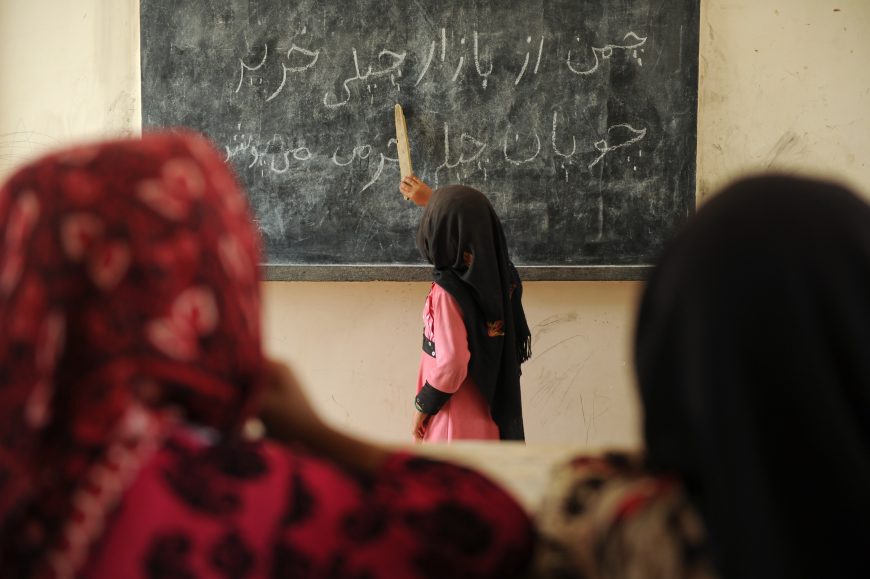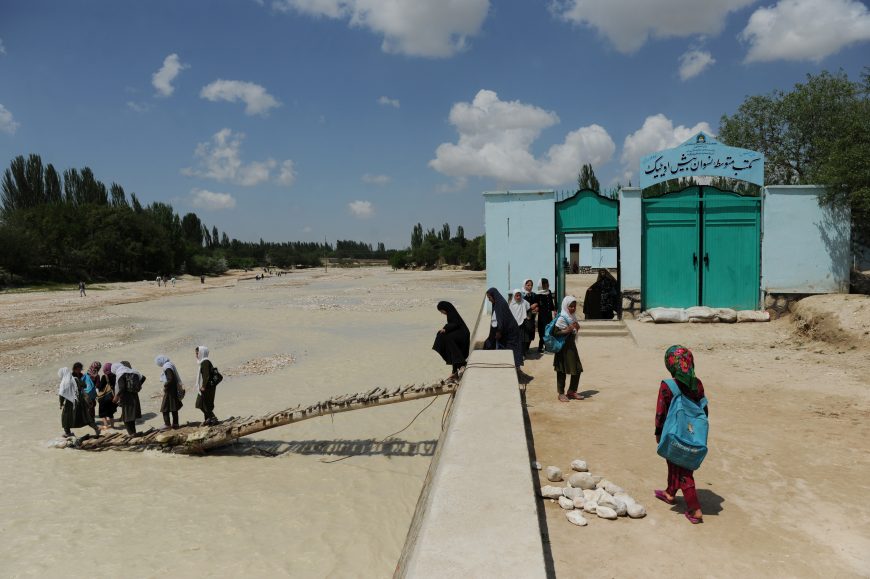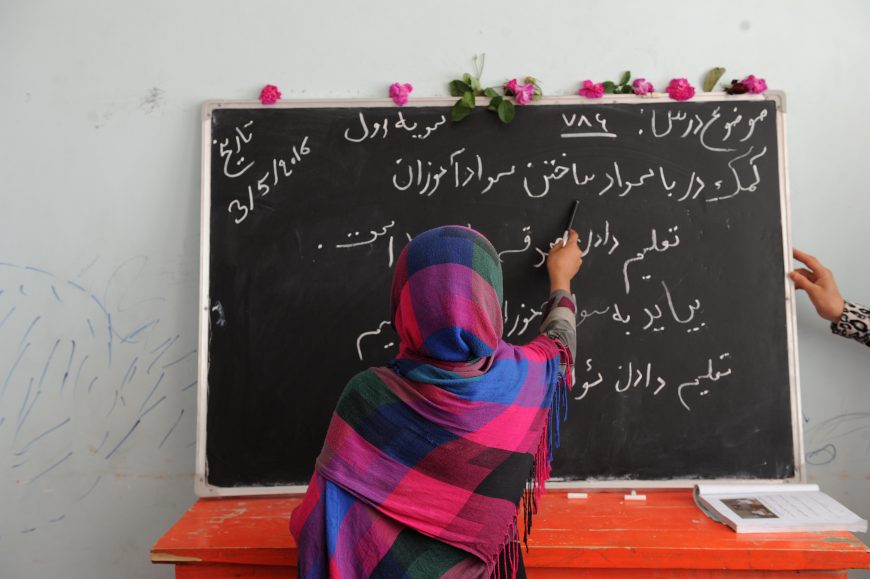
Since 2013, ACTED in Afghanistan has been implementing a DFID-funded education project aiming at increasing the quality of and access to basic education for marginalised girls in the Faryab province. The Faryab province is a particularly remote and conflict-ridden rural area of Afghanistan where government provision is still unable to meet the scale of needs, and the majority of girls are currently out of school. The project aims at addressing the main social, economic and practical barriers that prevent girls from accessing education and at overcoming the gaps in school coverage, disproportionately affecting girls.
Girls’ schooling in Afghanistan: situation update
After years of war and restrictions against schooling for girls, the literacy rate of Afghan women is still among the lowest in the world. The national literacy rate is 26%: 39% for men and only 12% for women. Gender parity ratio in primary education is 0.74, with 40% of boys and only 21% of girls completing primary school. Although the Afghan constitution enshrines the right to basic education for all, of the seven million children currently enrolled in school, only 37% are girls. Up to 42% of the total school-age population in Afghanistan remains out of school, and the majority of these are girls. Current government provision cannot meet the scale of needs, and Afghanistan remains off-track in meeting sustainable development targets on eliminating gender disparity in education.
Overcoming the challenge of girls’ schooling in Faryab province
The situation is particularly severe in remote and insecure rural provinces such as Faryab. An estimated 90% of women in Faryab are illiterate. However, the impact of girls’ education on the wider demographic and the inter-linkages between gender inequalities, economic growth and poverty are well recognised. In Afghanistan, infant mortality for mothers with no education is 74 per 1,000 live births. The infant mortality rate is reduced to 55 per 1,000 live births for mothers with secondary education or higher. Mother’s education level influences children’s immunization rates, and Vitamin A supplementation. Educated girls can help ensure a better care for male and female children in the future and increase well-being in present households. Thus, there is an urgent need to improve access, retention and quality of education for girls in rural Faryab, who are currently marginalised by geography, cultural restraints, gender inequalities and ongoing insecurity.

In Faryab, ACTED identified the main barriers that hamper girls’ education. One of them is the lack of separate and high-quality education facilities. Only 13% of the primary schools in Faryab are exclusively for girls. It is not acceptable for girls to go to a coeducational school in many conservative communities of Faryab, even if classes are separate. In an evaluation conducted by ACTED in Faryab, close to half of the parents said their daughters did not attend school because there was no separate girls’ school. Another barrier is the lack of quality teaching: professional teachers are not willing to work in remote areas, and the lack of incentivisation measures further enhances this phenomenon. Consequently, most of the teachers in Faryab are informal. Also, only 19% of the primary school teachers in Faryab are women, which is another factor hampering girl’s schooling in the province. Moreover, ongoing insecurity across the Faryab province seriously impacts girls’ education. Due to the lack of local schools, parents are not willing to let their children, particularly girls, travel long distances to reach schools. Moreover, because of poverty, girls often stay at home to help with household chores. Finally, early marriage is very common in the province and is strongly correlated to low percentages of education for women.
Increasing access to and quality of basic education for marginalised Afghan girls
To address those barriers to girls’ education in Faryab with a meaningful and sustainable approach, ACTED primarily conducted intensive community mobilisation activities to address demand issues and improve an enabling environment. Through these activities, ACTED engaged with local leaders, community development councils (CDCs), shuras (local village elderly councils) and religious leaders, to ensure community support and acceptance of girls’ education. To contribute to increasing the provision of quality, dedicated girls-only facilities, ACTED constructed ten girls-only primary schools. ACTED is committed to facilitating access to school, but also to the provision of a full cycle of primary education by handing-over the mission to the provincial government at the end of its action. In addition to the primary schools, ACTED also constructed seven female Youth Development Centres (YDCs) to reach out-of-school girls who may not be able to enroll in primary school for age reasons. The YDCs provide vocational training, literacy courses and other educational activities in a safe and culturally acceptable space designed for girls and women. The YDCs also provide nursery service for young mothers willing to participate. Moreover, the vocational training enables to address the economic barrier by allowing the economic empowerment of girls. Moreover, thanks to infrastructure construction, ACTED contributed to expand geographical coverage and opportunities for girls to access basic education opportunities within their communities, overcoming the issue of insecurity and increasing girls’ enrollment and attendance in schools.

In one village in Gormach district, 97% of children were out of school before a local girls school was established with the support of ACTED. Around 66% of parents said their children were now attending schools because it is safe, after schools have been constructed in their own village.
ACTED’s current educational interventions in Faryab are over-subscribed, particularly the innovative female YDCs, with over 500 female youth currently attending programmes initially designed for 200 persons. Requests from the communities themselves to extend these activities show both a felt need and demand-led remit to address some of the barriers to girls’ education.
Since 2013, ACTED has targeted around 15,400 girls with varying educational opportunities in Faryab.
With DFID funding, ACTED has enrolled 4,100 girls in ten constructed primary schools, trained 63 teachers, graduated about 10,500 girls from basic literacy and numeracy classes, and around 750 out-of-school girls have learned a vocation and graduated from training courses like tailoring.
Celebrating girls’ education
In July 2016, ACTED participated in the Girls’ Education Challenge organized by DFID and gathering different organizations like ACTED promoting education projects. ACTED presented the girls’ education project in Faryab to the participants and was able to interact with the Afghan minister of education.